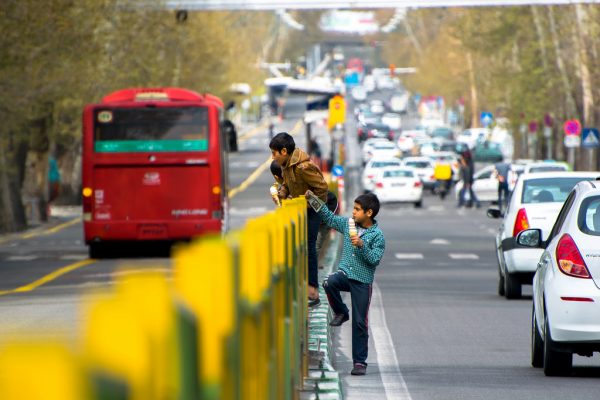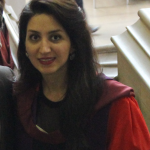
Image credit: Ali Rankouhi
Why does Iran have one of the biggest markets in the world for aesthetic surgery? In seeking the answer to this question, I found that a number of different factors are at play: the market for cosmetic surgery is informed by culture, geographic and urban spaces, religion, and even politics.[1]
In Iran, bodies are scrutinised to be physically “fit” within the narrowed-down standards of beauty, ability, health, gender, age, class and so forth. Cities have the power to constantly eliminate individuals’ bodies that are considered “unfit” for the urban space; these include, but are not limited to: the so-called overweight, oversized, obese, visually impaired and people with any mobility impairment, wheelchair users, the elderly, cyclists, runners and even people using pushchairs. In a sense, all people are dealing with some form of disability and at some point in their lives will become disabled by the city’s physical layout. The city’s physical structure reinforces the notion of ‘the right body’, and raises urgent questions around the right to access – a fundamental human right.
Yes, over past decades, efforts have been made to make the big cities in Iran friendlier for cyclists and for visually-impaired people, through tactile paving for example. However, these provisions are not maintained, nor are they always accessible. Paths are usually blocked or come to an end halfway down the road. Despite the ratification, in 2009, of the Convention on the Rights of People with Disabilities, disabled people are still limited by the lack of disabled-friendly infrastructure, and are therefore unable to assert a strong social and physical presence in Iran. In the absence of inclusive designs, wheelchair users, people with mobility impairments or the people using pushchairs are not able to use the city’s footpaths, recreation spaces and buildings without the help of others. In Iran today, you are likely to experience immobility or disability to some extent, regardless of your own individual “ability”.
Within and through these physical spaces, “atypical” bodies with social/medical labels (‘fat’, ‘obese’, ‘disabled’, ‘old’, ‘blind’) are materialised, and are cast out or seen in need of correction. Indeed, the material layout of the city determines how ‘correct’ or flawless a body is, and partly informs how individuals’ bodies are constructed as inherently problematic. The physical spaces affect people’s capacities to be (un)well, (dis)abled, (im)mobile, and in general, (un)fit. In essence, the social contexts, and more specifically urban spaces, do not make bodies fat or disabled but make these bodies “unfit”.
“Why cause trouble – for us, and for yourself?”
This is a common question in Tehran aimed at people whose bodies do not fit within the standards of normalcy. The material spaces – which are designed only for able, young, slim bodies – inform the experiences of place and become part of the person (or embodied), and reproduce the persons’ sense of “unfitting”. While the city council, normally, should be seen as responsible for such shortcomings and disabling arrangements, in practice the individuals with so-called “unfit” bodies become the target of the blame. They are pathologised to be “too fat”, “too immobile”, “too old”, even “too athletic”, and are encouraged to stay at home and keep out of trouble.
Bodies that transgress the boundaries of citizenship are removed from public view, and thus the definition of “right” bodies versus “wrong” bodies gets even narrower. The very absence of these excluded bodies helps shape public expectations and designate the boundaries of normality. The physical architecture of a public space – and the flow of people’s bodies in and out of that space – define the enactment of social life in public, all the while subtly influencing people’s thinking[2]. The Iranian city’s built environment can thus be held partly responsible for informing such views and leading people down the cosmetic surgery route.
On the issues of social justice and rights of citizenship, access to the built environment is uniquely important to the struggle for equality, because the segregationist ethos of society has quite literally been set in stone. Providing spaces for all people would facilitate their access to, and use of, public space by recognising their right to public space as citizens who are unique individuals and who have differences.
Researchers and policymakers need to work together in order to produce a more wide-ranging definition of “normal” in the social and physical spheres in which any non-normative bodies fit. Yes, researchers can play an important role in raising awareness of the right to access and (re)claiming the right to the city; but governmental support and the commitment of policymakers are paramount in the creation of physical spaces that acknowledge and welcome ALL people, along with any kind of ‘difference’.
[1] Kaivanara, M. 2017 “‘I Did It For My Self’: Ethnographic Study Of Cosmetic Surgery In Tehran, Iran”. PhD Thesis. University of Bristol. Bristol. UK.
[2] Amin, A 2006 “Collective Culture and Urban Public Space.” Excerpt from project “Inclusive Cities: Challenges of Urban Diversity”. The Woodrow Wilson International the Center for Scholars, the Development Bank of Southern Africa and the CCCB.

